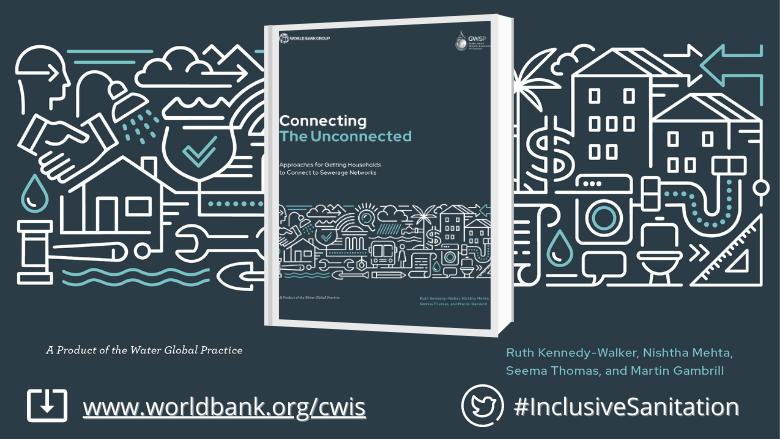Approaches for Getting Households to Connect to Sewerage Networks

*Download A Copy of the Guide NOW!
Cities and towns in low- and middle-income countries tend to grow rapidly, and they struggle to maximize the number of households provided with safely managed sanitation services, as defined by the Sustainable Development Goals (SDGs). This situation results in negative public health and environmental effects not only in the most vulnerable communities but also across urban agglomerations.
Providing sanitation services helps governments deliver on their commitment to SDG 6.2: achieving access to adequate and equitable sanitation and hygiene for all by 2030. In cities with existing sewerage networks, we often find many households not connected to networks even when they pass in front of their houses. In addition to negative public health and environmental effects, low sewerage connection rates mean that the wastewater treatment plants (WWTPs) to which the sewers should discharge are underutilized. This situation adversely affects the performance of treatment facilities, both from an operational and a financial perspective, reducing plants efficiency and returns on investments. For sanitation service providers, low household connection rates to sewers comes at a great cost, affecting their bottom lines, their financial sustainability, and their operational efficiency and ultimately creating a vicious cycle both financially and operationally because of lower-than-expected revenues.
Several reasons exist as to why households fail to connect to existing networks. Fortunately, successful programs around the world have tackled this challenge and, through a mix of responses, have managed to connect the unconnected.
This guide documents those experiences to help planners, engineers, decision makers, and other stakeholders navigate the process of increasing household connections to sewers. It also incorporates examples of condominial and simplified sewerage programs. The guidance and issues pertain to both conventional and nonconventional sewerage approaches.
This guide uses the World Health Organization (WHO) and UNICEF definition of a piped sewerage system: an active connection of sewerage pipes, also called sewerage, that receive both human excreta (feces and urine) and their flush water (collectively termed black water) and often handles “gray water” generated at the household level from sinks and showers. The combination of black water and gray water is called wastewater or sewerage (WHO/UNICEF 2006). Sewerage systems consist of facilities for collecting, pumping, treating, and disposing of wastewater. Household connections covered in this guide consist of two parts: the sewerage connection from the public sewer to the inspection chamber (which is usually the service provider’s domain and responsibility) and the pipework from the inspection chamber up to, and sometimes including, the internal plumbing of the household (which is usually the responsibility of the household).
This guide can help those involved in designing and implementing sewerage programs to think about household connections and figure out how to achieve them, whether retroactively after installation of a sewerage network or proactively during conception of a sewerage project so that household connections are part of the project concept from the outset. The guide defines the different typologies of connection to allow for a better understanding of current situations and of technical and customer-related issues that need to be addressed to increase household connections.
While not intended to be exhaustive, this guide provides an overview of key considerations for developing a sewerage connection program for either existing sewers or for new sewerage projects. For each stage of the project cycle, the guide unpacks key dimensions of a sewerage connection program, namely the social; financial; policy, institutions, and regulation (PIR); and technical aspects. The guide reviews a selection of successful and less successful programs from cities across the globe to identify ingredients that can help maximize connections to sewers, including those for low income consumers, while drawing on the principles of the Citywide Inclusive Sanitation (CWIS) approach. All the dimensions are critical, but the primary takeaway highlights the importance of community engagement—from inception through operation and management—thus underscoring the importance of the social dimension when undertaking the assessments, the designs, and the implementation of sewerage connection programs.